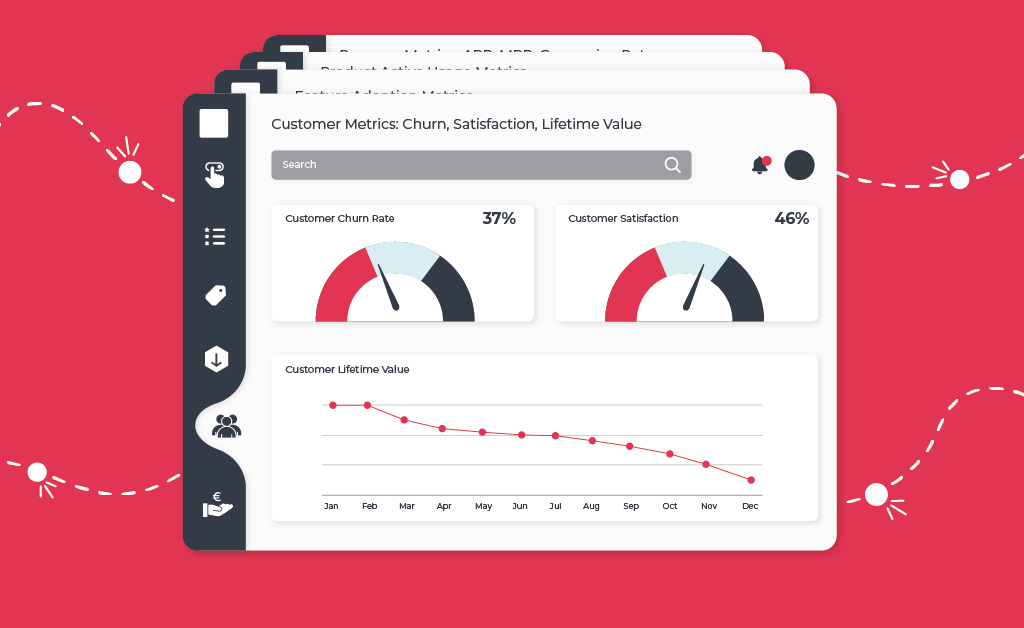
Updated on by Hayley Brown
While developing a new SaaS product, managers need to be defining and tracking key metrics. These help to effectively guide the product’s development and future deployment to customers.
SaaS product metrics, also known as KPIs are measurements and performance indicators. They evaluate the success of a product over a period of time which can help with iteration in the software development process.
Metrics and KPIs matter because they provide targets for organisations to aim for when developing and delivering a SaaS product.
SaaS Product Management Metrics
Now more than ever there is an abundance of data at SaaS product managers’ fingertips. All of which help to inform product development. These metrics or KPIs can be split into two categories. Firstly, SaaS business metrics and secondly SaaS product metrics.
SaaS Business Metrics
SaaS business metrics tend to focus and give insight into the marketing, and sales efforts of the business, as well as the revenue and growth. They are useful in helping to indicate the health of your organisation. As well as evaluate future progress towards your business’s long-term objectives.
Conversions are a useful SaaS metric to measure, as it focuses on a user or customer’s movement through a series of steps. This could be a signup or contact form on your website, or a customer moving through your sales process.
Monthly recurring revenue (MRR) is a financial SaaS metric, used to measure how much revenue your customers are generating in a single month. This metric can be used to calculate your Annual recurring revenue (ARR).
Customer Acquisition Cost (CAC) is a measurement of the amount you spend on sales, marketing and other associated costs in order to acquire new customers. This is useful for forecasting and budgeting purposes.
Lifetime Value (LTV) represents the total revenue generated by a customer over the lifetime of their account.
Churn could be either customer churn rate which measures the number of customers leaving your service each month. It could also be revenue churn, which measures the amount of revenue paid by customers leaving your service each month.
SaaS Product Metrics
SaaS product metrics on the other hand give useful data about the users, their behaviour and their habits in regard to your product and their overall satisfaction with it.
For instance, active users can focus on daily, weekly, or monthly users. It helps to understand how many customers are actually using your product, which can inform future growth and scaling.
Net Promoter Score (NPS) is a measurement of how much value a customer is gaining from your product. This is a useful SaaS product metric due to its ability to see what features are being used most, what could be improved, and areas that are being neglected by users.
Usage and behavioural metrics; can be broken down into separate metrics such as feature adoption or how much time users are spending within your product.
The importance of tracking metrics and KPIs
The role of a SaaS product manager is to define and scope a product’s features, incorporate company objectives into the product roadmap, and give developers and designers the requirements they need to deliver a strong product. Therefore keeping track of product metrics and KPIs is crucially important.
As metrics help a SaaS product manager, monitor the progress, and growth of a product. As well as evaluate the performance, customer satisfaction, and if there are any recurring issues experienced. Metrics and KPIs are also valuable during the product development process. Influencing the continuous iteration, and development of a SaaS product.
In continuously monitoring product metrics it can also influence your business strategy. Transforming it into a product-led growth first strategy. Product-led growth is a business methodology where user acquisition, expansion, conversion, and retention are all driven primarily by the product.
By understanding the value of your product such as, the functional core task(s) that your customers want to achieve, how customers feel about the result of executing that core task(s), and how customers want to be perceived by others. The more in tune you are with your customer needs the easier it will be to communicate your product’s value through free trials, or demos. This closes the value gap between perceived value and experience value when the product is delivered to customers. Linking your SaaS product metrics directly to growth and customer experience.
Automate your KPIs
Using an embedded integration platform can help you build native integrations, and automate your collection of SaaS metric data. By creating integrations to popular applications such as Google Drive, Excel, Slack etc. you’ll easily be able to collate your data through your application and your other regularly used platforms. As well as within a secure ecosystem with your customers, you’ll be able to monitor product session duration and other used product features.



